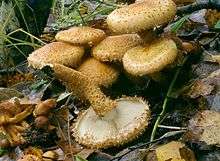Pholiota
Pholiota is a genus of small to medium-sized, fleshy mushrooms in the family Strophariaceae. They are saprobes that typically live on wood.[2] The genus has a widespread distribution, especially in temperate regions, and contains about 150 species.[3]
| Pholiota | |
|---|---|
 | |
| Pholiota squarrosa | |
| Scientific classification | |
| Kingdom: | Fungi |
| Division: | Basidiomycota |
| Class: | Agaricomycetes |
| Order: | Agaricales |
| Family: | Strophariaceae |
| Genus: | Pholiota (Fr.) P.Kumm. (1871) |
| Type species | |
| Pholiota squarrosa (Bull.) P.Kumm. (1871) | |
| Synonyms[1] | |
|
Agaricus "trib." Pholiota Fr. (1821) | |
Pholiota is derived from the Greek word pholis, meaning "scale".[4]
Taxonomic details
The genus Pholiota includes mushrooms, with scaly, glutinous to dry cap surfaces, and that frequently grow on wood or at the bases of trees or on decaying tree roots, and spores that are brown, light brown, or yellowish brown in deposit. These spores are smooth with a germ pore, although the germ pore can be quite narrow in species. Usually the species have pleurocystidia that include a type called chrysocystidia. There have been several varying concepts of the genus, ranging from a pre-molecular era very broad concept[5] that nowadays would include the genera Phaeolepiota, Phaeonematoloma, Flammula, Meottomyces, some Stropharia species, some Hypholoma species, Hemipholiota, Hemistropharia, some Kuehneromyces and some Phaeomarasmius, etc. Currently the genus is restricted to a smaller but still large group of species[6][7][8][9] that primarily grow on wood, causing a white rot, but other taxa occur on burnt ground following forest fires or camp fires, on peaty or forest soil, but none are known to be mycorrhizal. Many species have prominent partial veils and form an annulus or annular ring on their stipes. None of the species have purplish or purplish brown spore prints. None form acanthocytes on their mycelia.
Selected species
References
- "Pholiota (Fr.) P. Kumm. 1871". MycoBank. International Mycological Association. Retrieved 2011-12-23.
- "The genus Pholiota". The Mushroom Expert.
- Kirk PM, Cannon PF, Minter DW, Stalpers JA (2008). Dictionary of the Fungi (10th ed.). Wallingford, UK: CAB International. p. 524. ISBN 978-0-85199-826-8.
- Rea, Carleton (1922). British Basidiomycetaceae: a Handbook to the Larger British Fungi. Cambridge, UK: Cambridge University Press. p. 61.
- Smith AH, Hesler LR (1968). "The North American Species of Pholiota". New York, NY: Hafner. Cite journal requires
|journal=(help) - Moncalvo JM, Vilgalys R, Redhead SA, Johnson JE, James TY, Catherine Aime M, Hofstetter V, Verduin SJ, Larsson E, Baroni TJ, Greg Thorn R, Jacobsson S, Clémençon H, Miller OK Jr (2002). "One hundred and seventeen clades of euagarics". Molecular Phylogenetics and Evolution. 23 (3): 357–400. doi:10.1016/S1055-7903(02)00027-1. PMID 12099793.
- Walther G, Garnica S, Weiß M (2005). "The systematic relevance of conidiogenesis modes in the gilled Agaricales". Mycological Research. 109 (5): 525–44. doi:10.1017/S0953756205002868. PMID 16018308.
- Matheny PB, Curtis JM, Hofstetter V, Aime MC, Moncalvo JM, Ge ZW, Slot JC, Ammirati JF, Baroni TJ, Bougher NL, Hughes KW, Lodge DJ, Kerrigan RW, Seidl MT, Aanen DK, DeNitis M, Daniele GM, Desjardin DE, Kropp BR, Norvell LL, Parker A, Vellinga EC, Vilgalys R, Hibbett DS (2006). "Major clades of Agaricales: a multilocus phylogenetic overview" (PDF). Mycologia. 98 (6): 982–95. doi:10.3852/mycologia.98.6.982. PMID 17486974.
- Redhead SA. (2013). "(2128) Proposal to conserve the name Flammula (Fr.) P. Kumm.(Fungi: Agaricales) against Flammula (Webb ex Spach) Fourr. (Spermatophyta: Ranunculaceae)". Taxon. 62 (2): 401–2. doi:10.12705/622.16.
External links
| Wikispecies has information related to Pholiota |
| Wikimedia Commons has media related to Pholiota. |